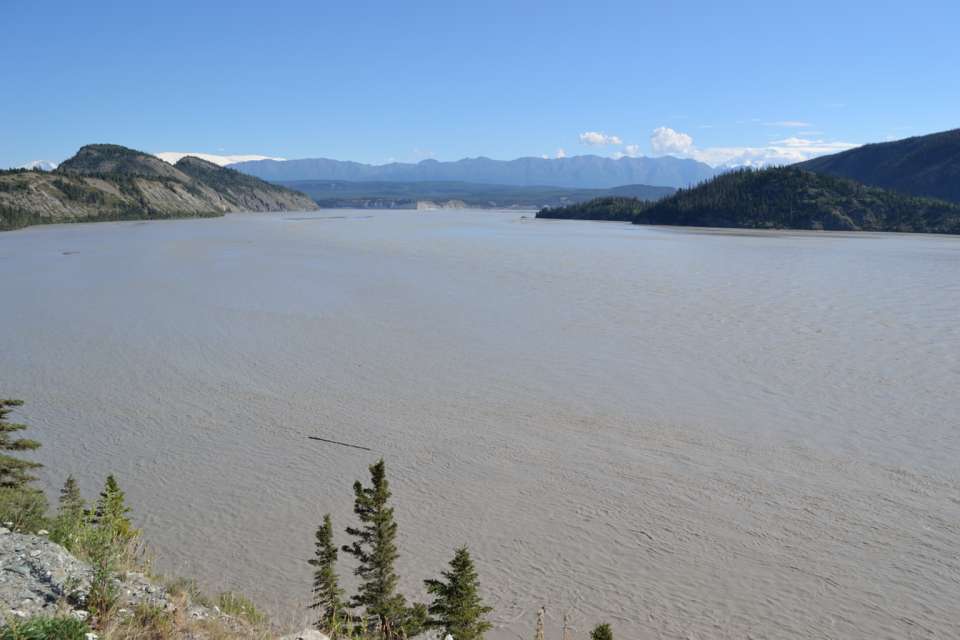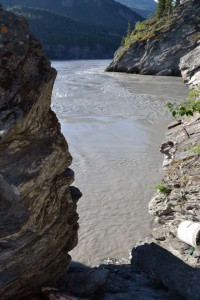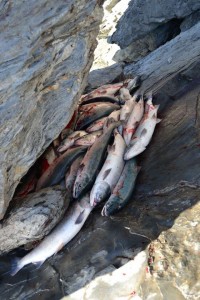I had wanted to go fishing for king salmon with hook and line earlier this year, but they’d closed it all over the state again due to poor runs. So I juggled deadlines at work with the dip-netting reports coming in from Chitina on the Copper River, and I finally threw things together and headed out on a Tuesday in late July when I could get away for a couple days and the report sounded like it was worth a chance. It was a beautiful drive – conditions were excellent. Driving as quickly as these ideal conditions permitted, I made it to O’Brien Creek just before 7:00 p.m. and dropped my life jacket in line to hold a place for the morning launch. It looked like I’d be on one of the first boats out. In speaking with folks to learn how the day’s fishing had been, things sounded so-so. A few of the dip netters had done well, but fishing was supposed to get better as the water dropped. As we spoke, one netter working the shore nearby pulled in several nice-looking fish, whetting everyone’s appetite.
The summer’s heat had caused a lot of glacier melting, raising the water levels and depressing the catchability of the fish trying to get upstream to spawn. The Miles Lake sonar downriver near Cordova showed large numbers of fish in the river – large enough for the Alaska Department of Fish and Game to open a supplemental harvest, an addition of 10 fish per household on a 30-fish permit. So my timing was good fish-wise, if only conditions cooperated. After a hot dog and a beer for dinner (one of the joys of camping is that nutrition takes a back seat to outdoor practicality and fun), I went to bed and set my alarm for 4:00 a.m. It was hot and noisy, though, so I didn’t sleep either well or long. Four-wheelers kept up their fishing activities in the camp and on the gravel trail all night long, and someone who must have had some successful fishing seemed to beat on their coolers and buckets for five hours, probably as they cleaned fish. The worst, however, was the 86 clowns who got out of a vehicle, with every one of them slamming a door as they left. I figure I slept about three whole hours, but I was up and ready to go before the alarm went off.
The weather was exquisite – a cool, clear dawn, calm and tranquil. The river was down a bit, and folks were cheerful, if tired, standing in line. The mood was upbeat and optimistic. I spotted a gorgeous backlit cloud above the mountains in pink and gold long before we saw the sun; it looked like a leaping salmon with a big crown on its head, and this seemed like a good omen. Soon Mark Hem, Sam McCallister, Daniel, and the crews showed up to prepare for a 5:00 a.m. departure. After a briefing on yesterday’s fishing, safety, and procedures, they collected our charter fees and loaded us up. I was on Mark’s boat, with Daniel as captain, and we were soon zooming down the turbid, roiling river in the pre-dawn light, admiring the river, the canyon, and the incredible summer weather.
We hadn’t gone far into the canyon when Daniel turned the boat upriver and pulled slowly into a steep, rugged rock face with a lot of roiling action at the waterline. The guy next to me had dropped his jaw and had goggled eyes as he said something like “Holy shoot!” (I’ve used my G-rated vowel replacement app here, you understand).
I laughed and said “I guess you don’t want this spot?”
“Hell, no!” he replied.
Once Daniel had the boat nosed into the rock and the engine throttled sufficiently to keep it there in the wild current, he pointed to me and said “Single guy!”
And off I went, happy to be so quickly dropped. It was the most dangerous spot I’d ever fished, and two things went through my mind as I unloaded gear and tried to find places on the steep, rugged rock face to put it where it would stay put: 1) They dropped people where they knew the chances of catching fish were highest, and 2) I remembered Sam McCallister saying last year something like “I bet you’ve fished just about every spot we drop people.”
Right on both counts, now. Daniel showed me where fish were caught here: at an interface where the strong downstream current met and fought hard with a strong, back-eddy upstream current out a ways from the shore. As they left, I got out the rope and tied off first the net (so I could retrieve it if I dropped it in the river), then myself. In the past I have always untied myself once I’d gotten familiar with the rock, but this time that seemed too risky, so I stayed tied off – with my lifejacket on, too – the whole time. Once I had us tied off properly on a sturdy spruce just uphill and the fish club and aviation shears laid out in handy positions, I put the net into the surging water to see how the fishing was. A very short time later, boom! There was one in the net.
It was so steep here that I had to devise a functional foot ballet, amazingly intricate, to get me and the fish and the net into a good position to knock the fish on the head, remove it from the net, clip a gill or two to bleed it, clip the tail tips as required by law, then carefully slide it (when it was clear that it was dead and not going to flop) into a crevice behind a huge, craggy rock to hold it until I had enough to load up a stringer. I carefully reversed the ballet, put the net back in the water, and boom! Another hit, but this one must have hit the outside of the net as it twisted in the wild current, because when I pulled it up again it was empty. Back down, work the current interface – and boom! I had another fish. Rehearse the ballet, drop the beautiful fish into the growing pile, reverse the ballet, and repeat.
I’d caught the first fish at 5:16 a.m., and previous experience had taught us to keep the nets in the water when the fish were hitting. By the time I had 10 fish I was bathed in sweat, and I broke long enough to take off my raincoat. By the time I had 20 fish I was still drenched with sweat and took a fast drink of water. This was a hard spot to work, because there was no place to brace the net, and you could not sit down and effectively fish. The current interface was a very dynamic thing, and I had to constantly keep the net moving to fish it effectively. One moment the net would be right up near shore, and the next I’d have it out all twelve feet working a whirlpool. It seemed like smaller fish liked the weaker currents near shore and that I’d catch larger fish out where the currents were harder. It is tougher to fish the latter, but the payoff was apparent today, so I kept working the harder areas of the interface that I could reach.
And so grew the pile. Amazingly fast. I had over 25 fish before the sun rose on my spot. I took only the briefest of breaks to drink water, keeping the net in the water and working that interface at all possible times. There never was a lull to stop and put fish on stringers, so the pile became quite large. When fishing is this fast it does not bother me that the fish get up to ambient temperature. Any longer, though, and I’d keep them cool in the river.
Things slowed down a little after the sun hit. Whether it was increased light or the changing current as the river rose a little, the bumps and catches slowed. I estimated that overall I was getting one bump-and-miss for every fish I caught. For all of the hot action, though, I only caught one double – all the rest were singles. And the foot ballet was so intense that I didn’t even notice it was a double until I had my feet carefully planted on the two-bump kill zone and brought the net the final way up the rocky bluff to prop it in place for the coup de grace.
Slow catching is all relative, though. It seemed to drop from a fish every three minutes to one every four minutes, and I had a chance to enjoy the scenery and glorious weather a little. But I passed 30 fish fast enough, and then reached 40 two hours and twenty minutes after starting. Amazing! Best fishing ever. We’ve never limited out before during a supplemental period. It was too bad that Rose hadn’t been able to experience it. But they probably wouldn’t have dropped the two of us off at this spot, because it was not one where you could really work two nets.
Not long afterwards I was cleaning fish back at O’Brien Creek, surprised that I’d beaten everyone else back in thanks to that great spot. With the fish gutted and iced down in two large coolers, I zoomed on back to Fairbanks, very happy with the day’s luck and with the great load of fish for winter.



